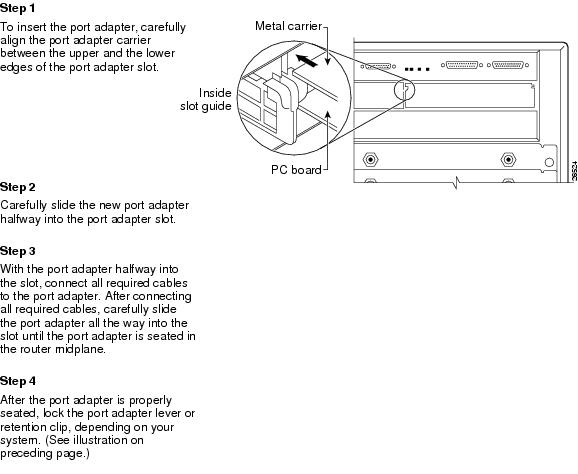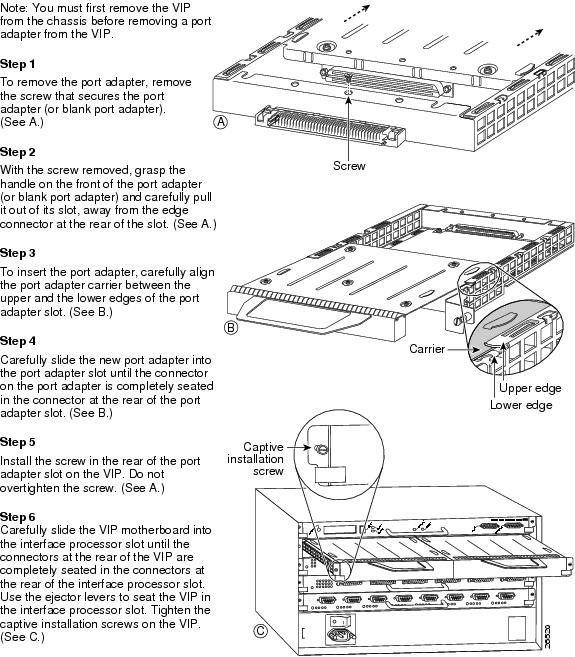- Title and copyright: PA-5EFL Ethernet 10BaseT-FL Port Adapter Installation and Configuration
- Overview: PA-5EFL Ethernet 10BaseT-FL Port Adapter Installation and Configuration
- Preparing to Install the PA-5EFL Ethernet 10BaseT-FL Port Adapter
- Removing and Installing the PA-5EFL Ethernet 10BaseT-FL Port Adapter
- Configuring the PA-5EFL Ethernet 10BaseT-FL Port Adapter
PA-5EFL Ethernet 10BaseT FL Port Adapter Installation and Configuration
Bias-Free Language
The documentation set for this product strives to use bias-free language. For the purposes of this documentation set, bias-free is defined as language that does not imply discrimination based on age, disability, gender, racial identity, ethnic identity, sexual orientation, socioeconomic status, and intersectionality. Exceptions may be present in the documentation due to language that is hardcoded in the user interfaces of the product software, language used based on RFP documentation, or language that is used by a referenced third-party product. Learn more about how Cisco is using Inclusive Language.
- Updated:
- September 14, 2007
Chapter: Removing and Installing the PA-5EFL Ethernet 10BaseT-FL Port Adapter
- Handling Port Adapters
- Online Insertion and Removal
- Warnings and Cautions
- Port Adapter Removal and Installation
- Cisco 7100 Series—Removing and Installing a Port Adapter
- Cisco 7200 Series—Removing and Installing a Port Adapter
- Cisco uBR7200 Series—Removing a Port Adapter
- Cisco uBR7200 Series—Installing a Port Adapter
- Cisco 7301 Router—Removing and Installing a Port Adapter
- VIP—Removing and Installing a Port Adapter
- Connecting an ST Fiber-Optic Cable
Removing and Installing Port Adapters
This chapter describes how to remove the Cisco PA-5EFL port adapter from supported platforms and also how to install a new or replacement port adapter. This chapter contains the following sections:
•![]() Port Adapter Removal and Installation
Port Adapter Removal and Installation
•![]() Connecting an ST Fiber-Optic Cable
Connecting an ST Fiber-Optic Cable
Each port adapter circuit board is mounted to a metal carrier and is sensitive to electrostatic discharge (ESD) damage.

Note ![]() When a port adapter slot is not in use, a blank port adapter must fill the empty slot to allow the router to conform to electromagnetic interference (EMI) emissions requirements and to allow proper airflow across the port adapters. If you plan to install a new port adapter in a slot that is not in use, you must first remove the blank port adapter.
When a port adapter slot is not in use, a blank port adapter must fill the empty slot to allow the router to conform to electromagnetic interference (EMI) emissions requirements and to allow proper airflow across the port adapters. If you plan to install a new port adapter in a slot that is not in use, you must first remove the blank port adapter.

Handling Port Adapters

Figure 3-1 Handling a Port Adapter

Online Insertion and Removal
Several platforms support online insertion and removal (OIR) of port adapters; therefore, you do not have to power down routers when removing and replacing a PA-5EFL port adapter on Cisco 7100 series routers, Cisco 7200 series routers, Cisco uBR7246 series routers, or the Cisco 7301 router.
Although the VIP supports online insertion and removal, individual port adapters do not. To replace port adapters, you must first remove the VIP from the chassis and then install or replace port adapters as required. If a blank port adapter is installed on the VIP in which you want to install a new port adapter, you must first remove the VIP from the chassis and then remove the blank port adapter.

It is wise to gracefully shut down the system before removing a port adapter that has active traffic moving through it. Removing a module while traffic is flowing through the ports can cause system disruption. Once the module is inserted, the ports can be brought back up.

Note ![]() As you disengage the module from the router or switch, online insertion and removal (OIR) administratively shuts down all active interfaces in the module.
As you disengage the module from the router or switch, online insertion and removal (OIR) administratively shuts down all active interfaces in the module.
OIR allows you to install and replace modules while the router is operating; you do not need to notify the software or shut down the system power, although you should not run traffic through the module you are removing while it is being removed. OIR is a method that is seamless to end users on the network, maintains all routing information, and preserves sessions.
The following is a functional description of OIR for background information only; for specific procedures for installing and replacing a module in a supported platform, refer to the "Port Adapter Removal and Installation" section.
Each module has a bus connector that connects it to the router. The connector has a set of tiered pins in three lengths that send specific signals to the system as they make contact with the module. The system assesses the signals it receives and the order in which it receives them to determine if a module is being removed from or introduced to the system. From these signals, the system determines whether to reinitialize a new interface or to shut down a disconnected interface.
Specifically, when you insert a module, the longest pins make contact with the module first, and the shortest pins make contact last. The system recognizes the signals and the sequence in which it receives them.
When you remove or insert a module, the pins send signals to notify the system of changes. The router then performs the following procedure:
1. ![]() Rapidly scans the system for configuration changes.
Rapidly scans the system for configuration changes.
2. ![]() Initializes newly inserted port adapters or administratively shuts down any vacant interfaces.
Initializes newly inserted port adapters or administratively shuts down any vacant interfaces.
3. ![]() Brings all previously configured interfaces on the module back to their previously installed state. Any newly inserted interface is put in the administratively shutdown state, as if it was present (but not configured) at boot time. If a similar module type is reinserted into a slot, its ports are configured and brought online up to the port count of the originally installed module of that type.
Brings all previously configured interfaces on the module back to their previously installed state. Any newly inserted interface is put in the administratively shutdown state, as if it was present (but not configured) at boot time. If a similar module type is reinserted into a slot, its ports are configured and brought online up to the port count of the originally installed module of that type.

Note ![]() Before you begin installation, read Chapter 2, "Preparing for Installation," for a list of parts and tools required for installation.
Before you begin installation, read Chapter 2, "Preparing for Installation," for a list of parts and tools required for installation.
Warnings and Cautions
Observe the following warnings and cautions when installing or removing port adapters.


Note ![]() If a port adapter lever or other retaining mechanism does not move to the locked position, the port adapter is not completely seated in the midplane. Carefully pull the port adapter halfway out of the slot, reinsert it, and move the port adapter lever or other mechanism to the locked position.
If a port adapter lever or other retaining mechanism does not move to the locked position, the port adapter is not completely seated in the midplane. Carefully pull the port adapter halfway out of the slot, reinsert it, and move the port adapter lever or other mechanism to the locked position.



Warning ![]() Hazardous voltage or energy is present on the backplane when the system is operating. Use caution when servicing.
Hazardous voltage or energy is present on the backplane when the system is operating. Use caution when servicing.
Port Adapter Removal and Installation
In this section, the illustrations that follow give step-by-step instructions on how to remove and install port adapters. This section contains the following illustrations:
•![]() Cisco 7200 Series—Removing and Installing a Port Adapter
Cisco 7200 Series—Removing and Installing a Port Adapter
•![]() Cisco 7100 Series—Removing and Installing a Port Adapter
Cisco 7100 Series—Removing and Installing a Port Adapter
•![]() Cisco uBR7200 Series—Removing a Port Adapter
Cisco uBR7200 Series—Removing a Port Adapter
•![]() Cisco uBR7200 Series—Installing a Port Adapter
Cisco uBR7200 Series—Installing a Port Adapter
•![]() Cisco 7301 Router—Removing and Installing a Port Adapter
Cisco 7301 Router—Removing and Installing a Port Adapter
•![]() VIP—Removing and Installing a Port Adapter
VIP—Removing and Installing a Port Adapter
Cisco 7100 Series—Removing and Installing a Port Adapter

Cisco 7200 Series—Removing and Installing a Port Adapter

Cisco uBR7200 Series—Removing a Port Adapter

Cisco uBR7200 Series—Installing a Port Adapter

Cisco 7301 Router—Removing and Installing a Port Adapter

VIP—Removing and Installing a Port Adapter

Connecting an ST Fiber-Optic Cable
On a single PA-5EFL you can use up to five pairs of ST fiber-optic connections. The PA-5EFL port adapter is an end station device and not a repeater; you must connect the PA-5EFL to a 10Base-FL repeater or hub. ST-type fiber-optic cables are not available from Cisco Systems; they are available from outside commercial cable vendors.
Connect ST fiber-optic cables to the PA-5EFL port adapter as follows:
Step 1 ![]() Attach the RX multimode fiber-optic cable directly to the RX port on the PA-5EFL. (See Figure 3-2.)
Attach the RX multimode fiber-optic cable directly to the RX port on the PA-5EFL. (See Figure 3-2.)

Note ![]() Port adapters have a handle attached, but it is not shown in to allow a full view of the detail on each port adapter's faceplate.
Port adapters have a handle attached, but it is not shown in to allow a full view of the detail on each port adapter's faceplate.
Step 2 ![]() Attach the TX multimode fiber-optic cable directly to the TX port on the PA-5EFL port adapter. (See Figure 3-2.)
Attach the TX multimode fiber-optic cable directly to the TX port on the PA-5EFL port adapter. (See Figure 3-2.)
Figure 3-2 Connecting PA-5EFL Port Adapter ST Cable Pairs—Front View

Step 3 ![]() Connect a PA-5EFLport adapter RX port to the appropriate TX port of the repeater, hub, DTE, or other external 10Base-FL equipment.
Connect a PA-5EFLport adapter RX port to the appropriate TX port of the repeater, hub, DTE, or other external 10Base-FL equipment.
Step 4 ![]() Connect a PA-5EFL port adapter TX port to the appropriate RX port of the repeater, hub, DTE, or other external 10Base-FL equipment.
Connect a PA-5EFL port adapter TX port to the appropriate RX port of the repeater, hub, DTE, or other external 10Base-FL equipment.
Step 5 ![]() Repeat Steps 1 and 4 for each additional PA-5EFL interface connection you require.
Repeat Steps 1 and 4 for each additional PA-5EFL interface connection you require.
This completes the procedure for attaching a multimode fiber-optic cable to the PA-5EFL port adapter. Proceed to "Configuring the PA-5EFL Port Adapter."
 Feedback
Feedback